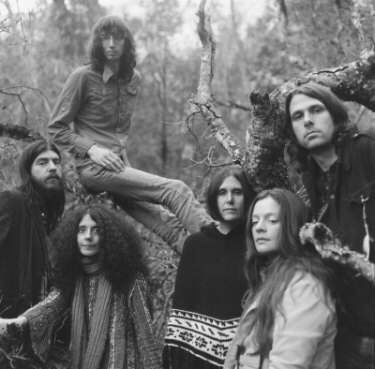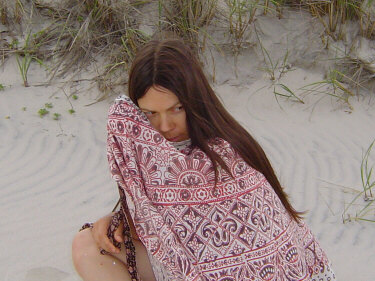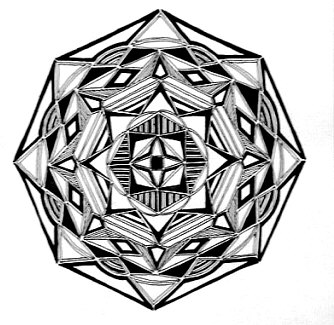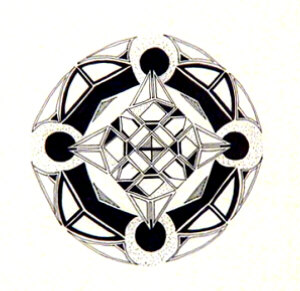1. Tripping Out and Tuning In

What is psychedelia?
What is loosely termed 'psychedelic music' has lately undergone a resurgence. Many mainstream musicians such as The Flaming Lips have drawn on its more accessible pop elements, drawing mainly from 60s British and American artists, while more alternative acts, such as the unequivocal Acid Mothers Temple and the splendid Swedish band Dungen, have moved deeper into the sounds of the 70s, infusing prog-rock with a more jam band sensibility.
At the leading edge of the psychedelic revival is a sub-genre often called psych folk, as it usually involves some fusion of traditional American and British folk elements alongside experimental forms, usually containing, but certainly not limited to, psychedelic tropes. Sometimes the folk sound takes precedent, and what is psychedelic is more subtle. In other cases, the folk elements are woven into noisy rock structures, often giving a kind of melancholia to discordant and aggressive frameworks.
There is no doubt that the rudiments of psychedelia are rather malleable. The use of electronics, looping, and found sounds, have helped turn a sometimes derivative musical genre into a serious creative platform. Yet it is still difficult to define precisely what psychedelia is, either musically or in terms of spiritual and mystical states of consciousness.
On the surface, the term “psychedelia” has long been associated with "Eastern religions," the amalgam of Hinduism, Buddhism, Taoism, and other traditions that became popular in the West in the 1960s. This is largely due to the efforts of American spiritual seekers who were discouraged by Jewish and Christian conceptions of God and saw other spiritual possibilities through the use of hallucinogens, only to find that states strikingly similar to those induced by LSD and mushrooms could also be found through "Eastern" meditation and spiritual practice. Ram Dass was one of the most important of these figures. Born Richard Alpert, Ram Dass was a young brilliant Jewish professor who, after getting kicked out of Harvard, along with Timothy Leary, for their infamous LSD research, went off to India in search of the kind of spiritual experience he had encountered on acid. After a few years of finding exactly that, he came back home and quickly became a leader of new spirituality of the soon-to-be baby boomers. Back home, Timothy Leary had already decided that any teachings he was looking for could be found in the drug itself and dubbed himself the “High Priest” of LSD.
The music of the 60s embraced both these approaches — Leary’s almost maniacal insistence on the efficacy of the drug experience as spiritual, and Ram Dass’s more patently religious Krishna infused, “Be Here Now” lifestyle — with a combination of spaced-out jams and Eastern sitar-soaked instrumentation, largely due to the influence of the Grateful Dead in San Francisco. On the one hand, mainstream musicians such as Pink Floyd and the Pepper-era Beatles, played with every manner of instrument and electronic effect available at the time. On the other hand, the 60s also saw a strain of neo-ludditeism, where many musicians wanted nothing more than to strip away all the conventions of modern society and return to a simpler approach. Think of the Band, Creedance Clearwater Revival, and, for that matter, the later Beatles of Let it Be (originally titled Get Back). The Rolling Stones provide a striking example of this contrast. Their 1967 release, Their Satanic Majesties Request is a sprawling psychedelic overload, replete with backward guitars and organs. Their next album, the 1968 Beggars Banquet could almost be a different band if not for Mick Jagger’s drawl. It is a stripped down roots-record, more blues than rock ‘n’ roll, and functioned as an internal and external reaction to the direction rock was ultimately moving.
Early on, however, psychedelic folk music was already its own sub-genre. Tyrannosaurus Rex (later the glam-rock stars T-Rex) and The Incredible String Band certainly drew from the same well as the more typical American psychedelic pioneers like the Grateful Dead, but along with rock ‘n’ roll and Eastern music, these bands called upon their non-American, but absolutely Western roots of British and Scottish folk. Despite how different this approach is from the swirling psych-out guitar jams of bands like the Dead, the intent was the same: the creation of a musically generated altered state, one that is reflective of the LSD experience.
Fast forward forty years. Today, in the US and Britain, there is a major underground movement that continues to build on the musical ideas of the psychedelic sixties, in particular those parts that held fast to the folk roots. Yet, unlike the Eastern-informed music of the 1960s, today's psychedelic artists are moving deeper and deeper into Western religious imagery and sensibility.
Gregory Weeks, a solo musician and member of the lush pastoral psych band Espers, explains this transition from East to West: “Eastern mysticism seems much more like an escape, whereas the natural world is there to be seen and felt. When something threatens the natural world, that threat is tangible, as are the rewards and examples of nature and environment.”
2. The Drone and the Guitar
This focus on the tangible is evident in the music of pysch folk, where the space-out of the jam has given way to more physical musical effect: the drone. Strictly speaking, a drone is any repetitive or sustained, usually dissonant chord, which creates a musical theme to ground the rest of a song or movement. Wagner’s Rheingold contains a classical version, but for the most part, the drone is usually found either in indigenous musics, such as that of the bagpipe, spiritual music such as the chant of Tibetan monks, and experimental and underground music, such as doom metal.
I can think of no more disconcerting and unsettling music than doom metal when it incorporates the drone. And yet there is something frighteningly gripping. Almost completely in opposition to any notion of transcendence, drone metal gets its energy from a subterranean volcanic core. The music can make you feel as if the very plates of the earth are shifting in your belly. Beyond the apocalyptic, which at its heart includes an idea of hope and final redemption, doom metal sounds the alarm that something is on its way and it isn’t good. And yet, the two most influential doom metal bands, Earth and Sunn0))), have both spoken in interviews about how theirs is a music intent on a kind of spiritual transport. The use of drone is key.
The almost inverted notion of transcendence, a kind of thick and muddy immanence, is what many psych-folk musicians have found in using the drone. Pat Gubler of the musical outfit PG Six, part of the Tower Recordings collective, plays largely traditional folk with deep and subtle drone elements woven throughout. Gubler remarks, “One thing that a drone does is gives the listener a very direct experience of resonance. It's a physiological experience. And performing drone music even more so, especially if you are singing. You are feeling the tones produced by your body.”
Gregory Weeks describes the drone’s relationship to psychedelia and spirituality: “The drone is absolutely the fastest way to induce the drug phenomena or mindset within a straight listener or audience. It's also a very introspective experience, for player and audience alike if done well. Drones are so simple, one would imagine they'd grow incredibly stale after several minutes, but instead they increase in interest and intensity in many cases. That's because listening to a drone is like watching a fire take hold. Invisible frequencies manifest in the ear much like an elusive green flame appears amidst the oranges and yellows. A fire never gets old, there's something primal and primordial about its engagement. Droning sonics are similarly primal in their appeal. They evoke strong responses, both emotional and physical within the listener and player alike.”
 In psych folk, while the drone helps sustain the potential for altered/spiritual states, it is the folk elements in the music that round out and layer the sound. Fursaxa, led by Tara Burke, is one of the more interesting bands that layers the drone and its ancient chant-like motifs with traditional folk, creating a unique kind of psychedelia. For Burke, using these elements is fairly deliberate, and yet, there is still something improvisational about it: “My folk elements are usually the instruments that I play — acoustic guitar, mandolin, balalaika, accordion — but when I craft a song I usually take the psychedelic approach and get in an altered state and compose my music. I also use various delay and loop pedals and such to achieve this.” These effects create an altogether otherworldly sound, and yet there is something eerily grounding about it. Burke continues: “For me music is more experimental and about blending different sounds together, sounds that can allow one to enter another world. I also hope that when people listen to my music they might think of plants and insects, or being lost in the woods, because these are things that are important to me and that I might be thinking about while making music.”
In psych folk, while the drone helps sustain the potential for altered/spiritual states, it is the folk elements in the music that round out and layer the sound. Fursaxa, led by Tara Burke, is one of the more interesting bands that layers the drone and its ancient chant-like motifs with traditional folk, creating a unique kind of psychedelia. For Burke, using these elements is fairly deliberate, and yet, there is still something improvisational about it: “My folk elements are usually the instruments that I play — acoustic guitar, mandolin, balalaika, accordion — but when I craft a song I usually take the psychedelic approach and get in an altered state and compose my music. I also use various delay and loop pedals and such to achieve this.” These effects create an altogether otherworldly sound, and yet there is something eerily grounding about it. Burke continues: “For me music is more experimental and about blending different sounds together, sounds that can allow one to enter another world. I also hope that when people listen to my music they might think of plants and insects, or being lost in the woods, because these are things that are important to me and that I might be thinking about while making music.”

3. The Other-Worldly and This
Music has long played an important role in religion, but the particular phenomena of the chant or other intonations has often been believed to be attuned to actual physical vibrations which have an effect on the actual body. The mystical experience is not just about the mind, but the whole self as it exists in space. In this way, the tension inside the pysch-folk sensibility, particularly with drone, becomes less about East versus West and more about a primary tension within any mystical experience: how close can you get to God before you are shattered?
One of the remarkable ways in which hallucinogenics mirror what we might call a traditional mystical experience is in the tension between the knowable and the unknowable. The psychedelic experience is often one of wavering between bliss and terror, between touching the fire of the holy and in turn being burned up by it. In all the great myths and religious traditions there are stories of mortals being warned to not try to get too close to the gods. And yet, almost all these traditions include stories of face-to-face encounters with the holy, what the theologian Rudolf Otto calls the mysterium tremendum, and which, according to Otto, is the only truly authentic relationship one can have with God. It is Moses coming down from Sinai as “the skin of his face was shining”; it is Jacob after seeing the angels descend and ascend who proclaims, “How awful is this place.” And so the very telos of the mystical experience is one that is fraught with danger. Ezekiel sees the chariot and all its glory, but Moses is told by God “No one shall look up upon me and live.”
Psych folk, when done well, can gracefully inhabit this space. This also means the music is often not what might be called joyful, but is rather filled with sounds of dread, of melancholy, of the noise in the soul as you realize your incantation actually worked and God is staring at you from the inside of the grove. For Weeks, this takes place less in the music itself, but in the performance: “Most any performer will tell you that the synergy and/or chemistry ignited while playing (and especially improvising) with other musicians is ‘magical,’ or ‘spiritual.’ I’ve never experienced anything like it outside of performance.”
Psych folk that employs the drone also plays in an important role in the cultural disconnect that is often part of using hallucinogens. There is important work being done regarding the efficacy of hallucinogens and spirituality. A new generation of psychedelic anthropologists, including Daniel Pinchbeck and Jeremy Narby, is trying to return the use of hallucinogenics back to their indigenous use, rooted in shamanism and ritual practice. But being able to take ayahuasca with the natives is not easy for the average seeker. Dropping a few hits of smiley-face blotter acid will likely only mimic a mystical state while the playing of music can itself become a vehicle for entering into an authentic altered state. Gubler explains, “Music itself can be more effective in producing a profound effect on a person. I think drugs can possibly amplify or enhance an experience, but drugs can also get in the way and in fact detract. I remember being younger and reading about the Merry Pranksters and kind of romanticizing the idea of a psychedelic experience being a truly spiritual one, but I found that in my own experimentation with drugs that didn't really happen for me. Comparatively, with music there have been many times in my life where I've been able to go somewhere else in my mind.”
Psych folk taps into this dichotomy even more than traditional 60s space-out psychedelia because its very affect seems rooted in actual experience, not pop pretension about being “mystical.” The Electric Prunes’s “I Had Too Much to Dream Last Night,” one of the great psychedelic rock songs of the 60s, has a somewhat empty spiritual conceit. The folk underpinnings of psych folk keep it all so grounded. The Castanets, a band characterized by a kind of American Gothic roots sound, reveal this even in their lyrics:
What good these myriad mythologies And what good these magics not to be released And what good unknowable divinity If it's not the world?
The folk element shows that only in the world can the mystical experience have a peculiar character. Ascending to great mystical heights is not the point. Rather, the roots sound theurgically draws down the holy. Put theologically, the difference between space-out and psyche-folk is the difference between ascent and descent. We find a similar difference  in the historical shift from Classical Kabbalistic to Hasidic mysticism. The former is mainly concerned with the experience of an other-worldly unity, most often in solitary communion. Hasidism sought to take whatever knowledge is gleaned from study and ritual and bring it to bear in the world as an ethical encounter. Where the mystic seeks to ascend the sefirotic tree towards the transcendent God, the Hasidic Zaddik, as Gershom Scholem explains, “is occasionally compelled to descend to a lower or even dangerous plane in order to rescue the scattered sparks of light…” to repair the world.
in the historical shift from Classical Kabbalistic to Hasidic mysticism. The former is mainly concerned with the experience of an other-worldly unity, most often in solitary communion. Hasidism sought to take whatever knowledge is gleaned from study and ritual and bring it to bear in the world as an ethical encounter. Where the mystic seeks to ascend the sefirotic tree towards the transcendent God, the Hasidic Zaddik, as Gershom Scholem explains, “is occasionally compelled to descend to a lower or even dangerous plane in order to rescue the scattered sparks of light…” to repair the world.
Arguably, the this-worldly orientation of contemporary psych folk — it is perhaps no coincidence that today's musicians are interested in Kabbalah and Christian/Pagan systems as thought as much as Eastern ones — makes it even truer to the psychedelic vision than the music of the 1960s. "The Sixties" as a cultural vision was born not only out of the drugs that fueled it, but the actual worldly situation. War, civil rights, sexual liberation, dastardly politics, created a need for a new holistic image of the universe. Eastern mysticism spoke to this need, with its teachings of the illusion of desire, the benefit of letting go of material goods, and its imagery: multi-headed colorful gods spinning around cosmic mandalas, free from the tether of technology and greed. But its politics were utopian, and thus ultimately unsuccessful.
For today's psych-folk musicians, spirituality exists in the tension between the great heights of ego-dissolution and the sunken buried claustrophobia of the self — not in the escape from one to the other. Pysch folk, particularly with drone, can have the qualities of an incantation, of a spell, the words learned first as a prayer, but manipulated into something magical. And yet, there is something oddly pragmatic about it. Like any good folk music, it is the music of community, of simple songs that become part of an oral/musical tradition, music that can be passed on. The subversive side of psychedelia — the effect pedals, reverb, looping — means that the community that will sustain it is also one that is of the 21st century. This combination of technology and the echoes of British folk partly gives psych folk a pagan quality. But this peculiar brand of musical mysticism more readily evokes a kind of pantheism: Holiness is hidden in the world; the right tool, maybe the drone of a computerized loop, can be the incantation to set it free.
For further listening:
Skygreen Leopards Life & Love in Sparrow’s Meadow (Jagjaguwar)
Fursaxa Lepidoptera (Atp Recordings)
Espers II (Drag City [Caroline])
PG Six The Well of Memory (Amish)
Samara Lubelski Fleeting Skies (The Social Registry)
Six Organs of Admittance School of the Flower (Drag City [Caroline])
Castanets First Lights Freeze (Asthmatic Kitty )
Akron/Family s/t (Young God Records)







